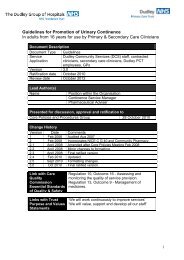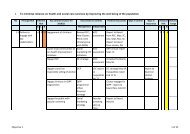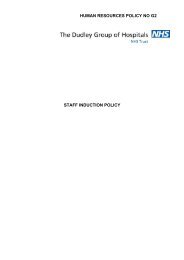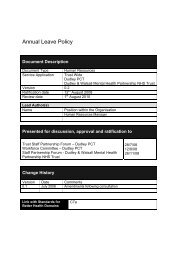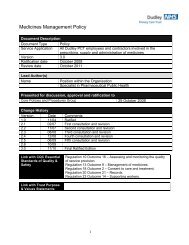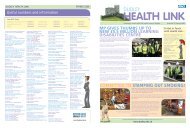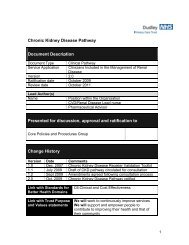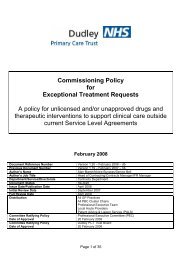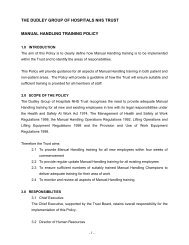Dudley Strategy for Tackling Health Inequalities 2010-15
Dudley Strategy for Tackling Health Inequalities 2010-15
Dudley Strategy for Tackling Health Inequalities 2010-15
- No tags were found...
You also want an ePaper? Increase the reach of your titles
YUMPU automatically turns print PDFs into web optimized ePapers that Google loves.
injustice and deprivation impact negatively on mental health and wellbeing, thusreducing individual and community resilience to cope positively with life‟s changes,challenges, and adversities (Friedli 2009, Foresight Project Report, 2008). Certaingroups often referred to as marginal, vulnerable or socially excluded groups andcommunities, are there<strong>for</strong>e more at risk of experiencing inequalities in health.Equality is about creating a fairer society where everyone can participate and hasthe opportunity to fulfil their potential, and social inclusion is the process by whichef<strong>for</strong>ts are made to ensure that everyone, regardless of their experiences andcircumstances, can achieve their potential in life. Under the new Equality Act <strong>2010</strong>which became law in October <strong>2010</strong> and covers the same groups that were protectedby previous equality legislation (age, disability, gender reassignment, marriage andcivil partnership, pregnancy and maternity, race, religion or belief, sex, sexualorientation), public bodies are accountable in terms of the equality and diversityagenda with clear duties to work towards eliminating discrimination and promotingequality of opportunity.A social gradient in health exists in that, better social and economic position resultsin better health (Marmot, <strong>2010</strong>). Marmot advocates a universal approach which alsorecognises the need <strong>for</strong> „a greater intensity of action‟ <strong>for</strong> those at „greater social andeconomic disadvantage‟. Some groups and communities experience limited or noaccess to a wide range of support, <strong>for</strong> example, older people, children and youngpeople, homeless people, people from minority ethnic communities, asylumseekers/refugees, economic migrants, prisoners, single parents, carers, looked afterchildren, mental health service users, people with physical/learning disabilities, gay,lesbian, bisexual and transgender peoples, and many others who are vulnerable andat risk. This is not a definitive list by any means and may vary depending on theparticular strategy, policy or service, but it gives an idea of which communities mayneed to be targeted to make a real difference to health inequalities.Key issues that have been identified in relation to work with all vulnerable groupsinclude, improving data collection and analysis, scoping of services to identify gaps,improving access, developing culturally relevant services, and working to eliminatestigma and discrimination. Strategies <strong>for</strong> health and wellbeing need to consider theseissues from the outset, and services need to address them in planning, development,delivery and review, in order to mainstream and integrate the diverse needs of alocal community.In this section of the strategy, the evidence from the Marmot Review is summarised;selected data available on the position in <strong>Dudley</strong> is presented; and finallyrecommendations are made on what needs to happen in <strong>Dudley</strong>.Based on Marmot‟s assessment of key policy areas to impact on the socialdeterminants of health, 4 areas are examined here <strong>for</strong> <strong>Dudley</strong>;- Early years; giving every child the best start in life.- Fair employment and good work <strong>for</strong> all.- A healthy Standard of Living- <strong>Dudley</strong> as a healthy and sustainable place.24




